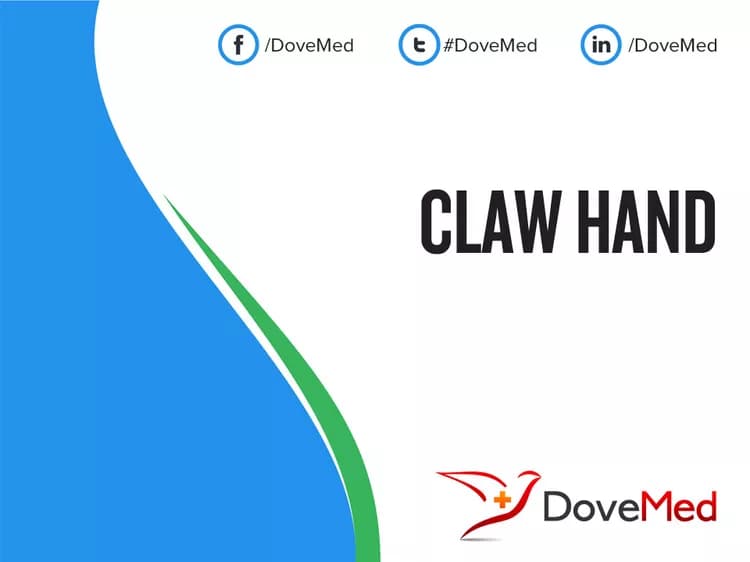What are the other Names for this Condition? (Also known as/Synonyms)
- Spinster’s Claw
- Ulnar Claw
What is Claw Hand? (Definition/Background Information)
- Claw Hand is a common deformity of the hand that causes abnormally bent or curved fingers. This abnormally makes the hand appear similar to an animal’s claw
- The condition may be caused by a congenital deformity that is diagnosed at birth (congenital onset), or due to an injury to the ulnar nerve
- Claw Hand is often confused with another condition, called Dupuytren’s contracture. However, Claw Hand does not produce nodules in the hands, unlike Dupuytren’s contracture
- Treatment measures associated with Claw Hand includes both non-surgical and surgical methods
Who gets Claw Hand? (Age and Sex Distribution)
- Claw Hand can be a congenital condition; it may be inherited or even acquired
- Men are more likely to develop the condition than women
- Congenital form of Claw Hand is common in both men and women
- There is no racial or ethnic preference observed
What are the Risk Factors for Claw Hand? (Predisposing Factors)
- There are no well-identified risk factors for the development of Claw Hand
- However, men are more likely to develop this condition than women
It is important to note that having a risk factor does not mean that one will get the condition. A risk factor increases ones chances of getting a condition compared to an individual without the risk factors. Some risk factors are more important than others.
Also, not having a risk factor does not mean that an individual will not get the condition. It is always important to discuss the effect of risk factors with your healthcare provider.
What are the Causes of Claw Hand? (Etiology)
A few causes of Claw Hand may include:
- Congenital abnormality (present at birth)
- Damage to the ulnar nerve, which occurs during birth
- Acquired paralysis of the ulnar and median nerves
- The development of scars following severe hand or forearm burns
- Ulnar nerve palsy, which can be both congenital or acquired
- Nerve palsy due to leprosy
Worldwide, nerve palsy due to leprosy is the most common cause of Claw Hand.
What are the Signs and Symptoms of Claw Hand?
The signs and symptoms of Claw Hand include:
- Bending or flexing of one or more fingers, towards the palm
- Deformity and numbness in the affected finger
How is Claw Hand Diagnosed?
The healthcare provider may use a thorough physical examination and a complete medical history evaluation to help diagnose Claw Hand. They may also perform:
- Close examination of the hands, comparing both hands to check for any signs and symptoms of the condition
- The physician may also test the range of motion of the fingers, to determine if there is any limited or constrained motion
Many clinical conditions may have similar signs and symptoms. Your healthcare provider may perform additional tests to rule out other clinical conditions to arrive at a definitive diagnosis.
What are the possible Complications of Claw Hand?
Complications of Claw Hand may include:
- Loss of function of the hand, resulting in an inability to perform basic functions
- Difficulty opening one’s hand
- Difficulty gripping large objects
How is Claw Hand Treated?
The treatment for Claw Hand includes both non-surgical and surgical methods, and this depends on the cause of Claw Hand.
Nonsurgical treatment measures for acquired form of Claw Hand include:
- Non-steroidal anti-inflammatory oral medications, such as indomethacin and naproxen, may be used to help decrease the pain and swelling
- Complete immobilization of the hand with a cast may be required, to restrict movement
- Corticosteroid injections may help provide temporary relief of symptoms and improve the range of motion
- Physical therapy: After symptoms have abated, it is important to begin some light motion exercises. Physical therapy may help restore strength, flexibility, and function of the hands. This can be used for congenital form of Claw Hand also
Surgical treatment measures for Claw Hand involve fixing the underlying issues contributing to the deformity. This can include nerve problems, tendon abnormalities, or scar tissue.
How can Claw Hand be Prevented?
There are no clearly established preventive measures for Claw Hand. However, early detection and treatment of the condition may improve patient prognosis.
What is the Prognosis of Claw Hand? (Outcomes/Resolutions)
- The progression of both congenital form and acquired form of Claw Hand can be unpredictable in many cases. The acquired form of Claw Hand also has a high rate of recurrence
- Approximately half of all cases of Claw Hand may recur, within a span of about 10 years
- Surgery, followed by rehabilitation, can usually restore the range of motion of the fingers, in the acquired form of the condition
- However, it is difficult to predict the prognosis for Claw Hand; the prognosis of Claw Hand depends on the cause
Additional and Relevant Useful Information for Claw Hand:
The following DoveMed website link is a useful resource for additional information:
Related Articles
Test Your Knowledge
Asked by users
Related Centers
Related Specialties
Related Physicians
Related Procedures
Related Resources
Join DoveHubs
and connect with fellow professionals


0 Comments
Please log in to post a comment.